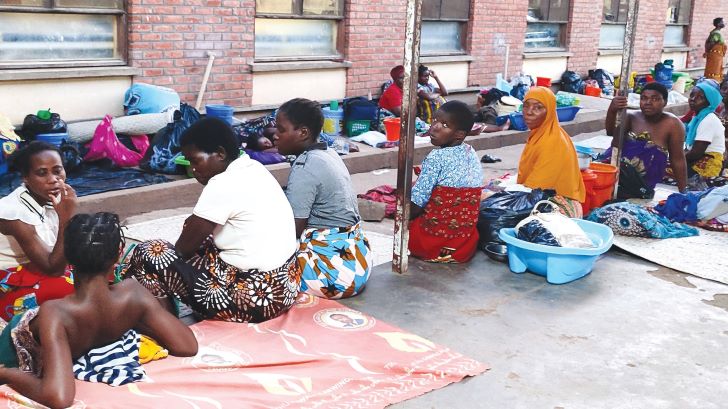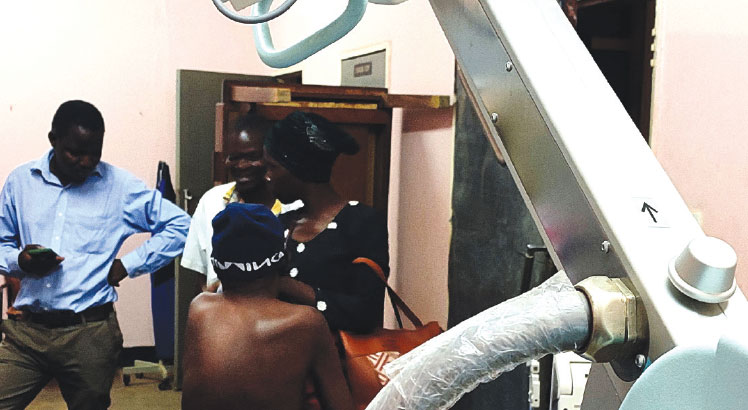It’s dreadful!
This is Machinga District Hospital. That mango tree over there serves as a maternity ward and a guardian shelter.
There are at least 30 expectant women and their guardians. They sleep under the tree, awaiting the arrival of their bundles of joy.

Apparently, the maternity ward at the hospital that opened its doors in December 1996, is too small to accommodate all expectant women.
Precious Maperera, from Samati 1 Village, Traditional Authority Amidu is expecting her second child.
She has been under this tree for nine days.
When it rains, she bravely bites her lower lip, bracing herself to be drenched.
“The space inside the hospital cannot accommodate us and we are told to wait outside. It is a tricky situation, but there is nothing we can do. We sleep here without mosquito nets,” she says.
The hospital’s spokesperson Wongani Nyirenda said expectant women sleeping outside the facility is an age-old problem.
He said authorities have been asking well-wishers to help construct a waiting shelter, but so far no one has come forward.

But Maperera is the face of millions of Malawians who rely on a crumbling healthcare infrastructure which barely meets Medical Council of Malawi (MCM) minimum standards.
We visited six hospitals of which 90 percent barely meet the minimum standards.
The standards include availability of qualified and licensed medical personnel, adequate equipment and supplies, proper infrastructure and waste management.
We also relied on MCM’s assessment of Christian Health Association of Malawi (Cham), public and private health facilities and the results paint a bleak picture of the state of health facilities nationwide.
Machinga District Hospital, according to hospital officials, uses old X-ray machines and sterilisers which do not function properly.
We found at least 50 people in need of X-ray, but they could not be helped as it had broken down.
“In a day, we have an average of 40 people in need of the X-ray machine. We rely on Zomba Central Hospital to prevent keeping patients waiting. All our health centres do not conduct operations, yet we have these problems,” said Nyirenda.
He also said patients eat once a day because of funding challenges.
The hospital,which serves a population of over 800 000, has 23 satellite health centres.
Visit to other hospitals
A visit to Dedza District Hospital on November 7 2023 found a dysfunctional anaesthesia machine, rendering major surgeries impossible.
At least 30 patients were seen queuing for a single X-ray machine.
And because of staff shortage, one medical personnel attended to 2 000 patients.
Ideally, the hospital hoped for a 1:1000 patients ratio under the circumstances.

Hospital spokesperson Mwayi Liabunya said they serve a population of 908 487 in their catchment area as well as patients from Mozambique.
In-patients are served only breakfast and lunch because of funding problems
In Chikwawa, most health centres lack structures to accommodate various departments.
The district hospital was built in 1937 and serves a population of over 628 000. It also has 20 satellite health centres.
However, it has one operating theatre that cannot cater for eye, bones, maternity and general surgery.
There is also no waiting shelter for antenatal women while the hospital’s dilapidated mortuary has a capacity six bodies, and usually breaks down especially during the hot season.
District medical officer Dr. Wamaka Msopole said they have a shortage of institutional houses at Majete 1, Majete 2, Majete 3, Majete 4, Majete 5, Majete 6, Therere and Nchalo health centres.
“One of our biggest challenges is the high vacancy rate at 54 percent. Lack of health workers leads to compromised care for patients. Health workers’ welfare is also compromised leading to burnout and stress,” he said.
Mulanje District Hospital also faces problems of staffing, lack of key equipment and spacing.
Senior clinician Martin Malunga said the facility caters for over 750 000 people.
He said it has been operating without plaster of Paris for months.
Malunga said each health centre is supposed to have an ambulance, but they only had four serving 17 health centres.
According to biomedical engineering technician Alick Kamvagugu, most of the hospital’s equipment needs replacing.
In the case of Phalombe District Hospital, which opened its doors in October 2022, the challenge is poor funding.

At the time of the interview in November 2023, district medical officer Dr Leonard Naphazi said the facility was receiving K24 million a month, an amount they used to get when they were oparating as a health centre.
He said the amount only covers fuel, water, power and locum expenses.
They struggle to buy food, stationery and cleaning materials and they have only two medical doctors.
As for Salima District Hospital, it is in a state of disrepair. The ceiling is worn out and windows have no glasses.
We were not allowed to inspect the hospital as officials were reportedly in Lilongwe for other duties.
Toilet used as pharmacy
MCM closed facilities operating below its benchmarks last October following an assessment it carried.
The benchmarks, among others, look at the quality of equipment and supplies, personnel, infrastructure and services offered.
MCM director of professional pract ice and regul a tor y enforcement Richard Ndovie confirmed that they closed down some facilities and recommended construction of new infrastructures while others were fined.
Ndovie said his office also inspected facilities in various districts which revealed serious gaps in the country’s healthcare delivery system
In Zomba, MCM assessed 76 health facilities with dilapidated infrastructure, inadequate equipment and supplies, lack of suction machines, wheelchairs, drip stands and instrument storage drums in dressing rooms.
They also encountered shortage of space and staff in the clinical section, no oxygen concentrators, poor infection prevention, no updated emergency tray, no clinicians at some health facilities, no resuscitation equipment, no incinerator, and some hospitals had no maternity sections.
At least 59 health facilities were assessed in Kasungu, including the district hospital, community and rural hospitals, health centres, institutional facilities and private clinics, exposing inadequate equipment and supplies as well as poor waste management in some facilities.
According to MCM, the hospital with acatchment polutaiton of 3 285, was using a toilet as a pharmacy and treatment room as a dressing room.
There was also no incinerator for medical wastes and the partitioning was sub-standard.
An assessment of Chamama Kasalika and Dwangwa health centres revelaed dilapidated buildings with no piped water.
With the current status, Ndovie said the regulatory body is forced to use minimum requirements or standards to certify a new health facility or to monitor the status of the existing health facilities during routine inspections.
“For those who are building a new medical facility, we are mandated to license health facilities under its jurisdiction..
“During the inspection, the facility may fulfil the requirements and the council licenses it or [if it] operates below the requirements, it is not allowed to open until the shortfalls are rectified,” he said.
Ndovie said some health facilities are operating below minimum standards on human resources, infrastructure, infection prevention, disposal of medical wastes, availability of equipment and supplies such as diagnostic sets.
“The proprietors are given time to rectify the shortfalls. And if the facility does not comply then the council closes the facilities.
“Many hospitals in Malawi are below minimum requirements, but by continuing monitoring and engaging them, the council aims to improve the quality of care for the benefit of patients and the health workers,” he added.
Health professionals lament crumbling system
Society of Medical Doctors in Malawi president Dr. Victor Mithi said local hospitals lack medical supplies, support, diagnostic, investigative equipment and enough health care workers.
He said even well-trained doctors would in present circumstances offer poor services to patients.
“Most deaths in Malawi are preventable. The system is killing people instead of helping them because of these shortages. However, I should state that the government is trying to improve the situation by recruiting people. There is hope, but the situation leaves a lot to be desired,” he said.
Nurses and Midwives Association of Malawi president Shouts Simeza said they are operating on a ration beyond the prescription of the international or global regulator such as the International Council of Nurses and Confederation of Midwives.
“We find it difficult in terms of service provision because the workload is beyond the prescription of the international bodies. We are working in a setup where medicines often lack. This compromises the delivery system.
“Patients are getting a raw deal which is dangerous and risky. However, we should thank the government for adjusting the funding which we hope will help in the recruitment of nurses, buying medicines and equipment,” he said.
M a l a w i O r t h o p a e d i c Association president Moreen Sabawo said her department, which focuses on trauma and orthopaedic delivery in Malawi, is facing equipment challenges such as lack of plaster of Paris (POP).
“This is basic equipment, which means without that we are affected in service delivery. We also have staff challenges with few orthopaedic surgeons,” she said.
Parliamentary Committee on Health chairperson Matthews Ngwale attributed the challenges to poor financing.
He said he doesn’t see Malawi recording substantial improvement.
Malawi Health Equity Network executive director George Jobe said they have been advocating a change in funding which might help the Ministry of Health to address challenges.
“The situation is worrisome; let me ask those in government, Parliament and the society, this is the time to change things because when we retire, we will go back to the village and bank on the same environment we are neglecting today. We should not prepare for doom, but influence change,” he said.
Jobe thinks if Malawi stuck to the 2001 Abuja Declaration to allocate at least 15 percent of their annual budgets to the health sector, things would be better.
In 2011, 10 years after the declaration, 27 African countries increased the proportion of their expenditure allocated to health.
However, only Rwanda and South Africa reached the 15 percent target.
The current K729.47 billion or 12.2 percent health allocation is the highest in the current K5.9 trillion National Budget
Malawi has since 2017 failed to recruit health care workers, culminating in a 63 percent vacancy rate.
But this year, government has allocated funds for the recruitment of 5 000 health care workers.
To date, recruitment of health care workers has been bankrolled by donor partners such as the United States President’s Emergency Plan for Aids Relief the Centre for Diseases Control and Prevention, the Global Fund and the Health Joint Fund.
The World Health Organisation (WHO) recommends that a population of 1 000 should be served by at least five health care workers, but in Malawi the same population is served by 0.5 health care workers.
The Human Resources for Health report shows that Malawi has 90 medical officers, 201 clinical officers, 247 medical assistants, 66 optometry technicians, 42 anaesthetic clinical technicians, 22 orthopaedic clinical technicians and 3 012 nursing officers, nurse midwife technicians and community midwifery assistants.
In 2023, the government allocated K27.7 billion towards the drug budget. Between 2019 and 2022, the drug allocation in the annual health budget dropped by almost 16 percent from 25.6 percent in 2019/20 fiscal year to 9.8 percent 2022/23 fiscal year.
Government said it requires K32 trillion to implement the Health Sector Strategic Plan III to build strong and holistic health systems from this year to 2030. The goal is to move towards Universal Health Coverage by improving health status.
In April this year, WHO listed Malawi in a group of 55 countries with the most pressing shortage of health workers.
Kamuzu Central Hospital, one of the country’s main ophthalmic conditions referral facilities, is failing to provide specialised eye surgery services due to lack of equipment. Currently, the government spends over K400 million to send eye patients to foreign hospitals, especially in India for surgeries.





